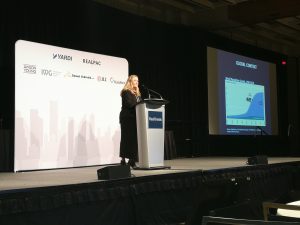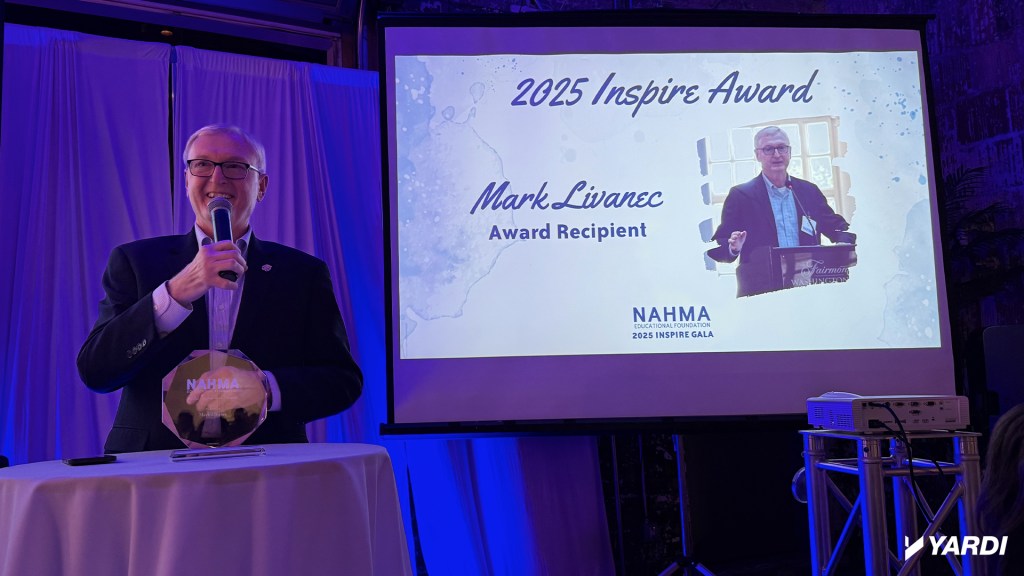By Erica Rascón on November 9, 2019 in Events News
What role does your organization play in the future of smart buildings and smart cities? How can you tap into the benefits today? Commercial property professionals tackled those questions and more at the 2019 Real Trends Conference.
In the commercial real estate trends discussion “Co-chair Insights: Politics, Demographics, and Technology” Amy Erixon, head of global investment management at Avison Young-Investments Canada, was joined by Sheila Botting, senior partner & Canadian real estate leader at Deloitte. They posited government-owned territories and creative commercial assets can bolster the nation into a prosperous future.
The available land is the ideal foundation for smart infrastructure and smart buildings. Thoughtful commercial spaces upon that land lends itself to creating buildings that are flexible and scalable. The “2019 Office Tenant Preference Survey Presentation” and “Smart Cities and Smart Buildings” sessions explored how space is a canvas for economic success.
2019 Office Tenant Preference Survey Presentation
Heather Brady, national director of sales for Yardi Canada, lead the session on the first office tenant preference survey sponsored by Yardi. This year will serve as a benchmark to more robust and relevant data gathered in the future.
Survey responses can help owners make more informed and proactive decisions about land use as well as space use within their structures.
Most Requested Features in Commercial Spaces
Survey participants expressed high demand for the following:
- elevators
- WI-FI
- natural light
- conference rooms within the office space
- parking lots
- ability to receive packages during work hours
- exterior green space
- energy efficient lighting
The survey also explored how telecommuting influences the way that tenants request and use space. Currently, 51 percent of tenants’ employees can work from home but only 3 percent do so full time. This reflects the growing inclination towards more flexible workspaces. As the telecommuting ratios change, tenants want the option to convert space to group use and conference rooms.
Survey information may be used to influence investments and other decisions. “Don’t forget, we are in a war for talent,” said Brady. “Results from the survey can help you better understand the tenants needs and how to make cost efficient decisions.”
Smart Cities and Smart Buildings
All of the discussion on smart buildings and smart cities had many attendees wondering, How can we make existing spaces smarter? What does all of this mean for our existing assets and city infrastructure?
To examine this topic, Monika Jaroszonek, CEO & co-founder of Ratio.City, moderated a panel including Pino Di Mascio, director of planning at Sidewalk Labs; Ken Greenberg, principal of Greenberg Consultants Inc.; Thano Lambrinos, vice president, smart building technology and digital innovation for QuadReal Property Group; Charlie Musgrave, senior director, office leasing, North America at Ivanhoé Cambridge; and Karl Schober, senior associate of Dentons Canada LLP.
Rethinking the Standards
Is our current use of space and understanding of space the best option available? Automobile access influences the use of urban spaces. Greenberg prompted attendees to question the global relationship with automobiles as part of system thinking. “Was the automobile era a terrible mistake? We need to think about what it is doing to us long term.”
Rather than continuing with a flawed system, attendees were encouraged to scrap conventional ways of thinking about buildings and city infrastructure. Instead, build better cities and offices from the ground up, concept by concept.
Lambrinos explained, “Energy efficiency, sustainability, health and wellness, user experiences are our guiding principles to drive value.” Each principal requires re-evaluating the status quo.
How do you apply that critical lens in the planning process? Di Mascio proposed starting with the problem to be solved and then addressing it without regard to current standards. Creating new standards is the only way forward. Di Mascio cited SideWalk Lab’s use of mass timber to build taller yet more affordable buildings and digital electrical grids to promote safer power access as two examples of rethinking what’s possible.
Privacy + Trust
Smart spaces require access to seemingly endless sets of data. Honouring the value of personalized data may clash with a city’s or building’s need to collect data for legitimate purposes that society deems meaningful.
Greenberg said, “Unlike with a service like Netflix, obtaining consent is not practical in smart cities because we have to follow PIPEDA. So there needs to be change in privacy laws.”
Currently, there are minimal regulations on the use of sensors in public spaces. Data can be gathered without user consent. Di Mascio proposed that data governance should be a top priority for cities. To lead the way, Sidewalk Labs is setting a new standard for data management, usage, and user consent. Panelists agreed that private entities are better equipped to manage cities’ transitions into the smart age.
“Why can’t the city do this on their own? Why do we need SWL?” asked Greenberg. “Toronto is not ready to make the leap of sustainable development. Research and development take the most time and money. In Toronto, we have not been able to go beyond giant garbage trucks. The city is divided into silos, making it difficult to find the right solution.”












